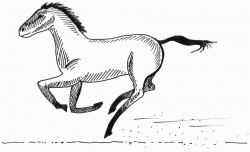Flying horses: Twas photoman Muybridge who concluded 'yes'
Q. Can a horse fly? Seems like nonsense, yet the question prompted railroad baron and former California governor Leland Stanford to join forces with photographic wizard Eadweard Muybridge to provide an answer. What's the full story? –M. Boyle
A. It was the 1870s, a time of technical explosion with the invention of the telephone and phonograph, and with Thomas Edison about to unveil the light bulb, reported Stanford University Magazine. The scientific world was also debating whether a galloping racehorse lifts all four legs in the air at once, with advocates swearing they did and opponents vehemently denying it.
Enter advocate Leland Stanford, future university founder and avid horseman, whose interest was to clinch his pet theory. He turned to Muybridge for help. It took five years of experimentation, but the photographer got the shots, using 12 cameras whose shutters were triggered by wires stretched across a racetrack. Muybridge's 1878 film stunned the world when he caught a galloping horse in the act of "flying," with all four legs off the ground.
"Those hoofbeats reverberated in art and science and are still being heard today,” the magazine reports. “And in pursuing for Stanford the secrets of equine gait, Muybridge unwittingly set the stage for a spectacular invention– the motion picture."
Q. What is the name for a sentence that contains all 26 letters of the English alphabet? –A. B. Fox
A. The above sentence is not a "pangram" but "The quick brown fox jumps over the lazy dog" is. It uses the letters from a to z, making it a traditional favorite for testing out a new typewriter or keyboard, says Oxford University Press.
You'll notice that some letters in this sentence are actually used more than once; there's no ready example of a sentence that uses all the letters of the alphabet once only. Of course, that doesn't mean it would be impossible for you to find one.
Q. Aside from a hangman's noose, was there ever a more dreaded thing strung around a guy's neck than an infernal necktie. So, what's the point? –D. Niven
A. Neckwear goes back thousands of years, to neckwraps of Chinese soldiers circa 221 B.C. and Roman soldiers a few centuries later, says clothing and textiles researcher Kathleen Huun. The modern necktie is traced to the cravat worn by Croatian mercenaries brought in by Louis XIII during the Thirty Years War (1618-1648), soon to be copied by the French. The accessory's unmistakable military origins help explain its strong association today with the masculine wardrobe.
"In psychological terms, this vertical, linear accessory has become the erotic symbol of men's wear," Huun writes.
Due to its conspicuous position on the body, the necktie is ideal as a statement-making billboard: "I am wealthy." "I work with my head, not my hands." "I belong to such-and-such a club, fraternity or group."
Refusal to wear a tie, or wearing one that’s flamboyant or untraditional, are statements of their own. University of California psychologist Susan B. Kaiser adds that while the basic "uniform" of suit, shirt and tie goes back about 100 years, its roots trace back even earlier to the growth of a "business class" mentality in Western culture. This entails a masculine denunciation of style, a disdain for what seems too feminine or frivolous to succeed in the business world. The look can also be associated with the Protestant ethic of some denial of pleasure along with a lot of hard work if one wants to get ahead.
At least the tie, though uncomfortable and essentially useless, does "allow for some color and creativity within a carefully defined and small space,” Huun writes. “It provides an outlet for expression that the rest of the look cannot."
~
Send your Strange questions to brothers Bill and Rich.
